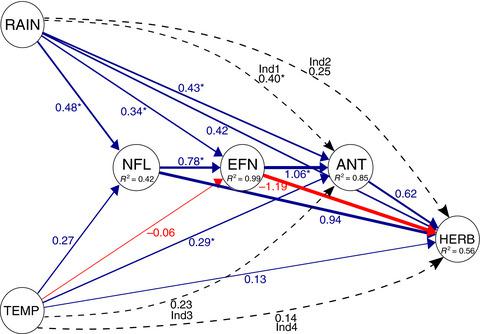Our official English website, www.x-mol.net, welcomes your feedback! (Note: you will need to create a separate account there.)
Climate seasonality drives ant–plant–herbivore interactions via plant phenology in an extrafloral nectary‐bearing plant community
Journal of Ecology ( IF 5.5 ) Pub Date : 2020-08-13 , DOI: 10.1111/1365-2745.13492 Eduardo Soares Calixto 1 , Letícia Rodrigues Novaes 2 , Danilo Ferreira Borges dos Santos 1 , Denise Lange 3 , Xoaquín Moreira 4 , Del‐Claro Kleber 1, 2
中文翻译:

气候季节在花蜜外生植物群落中通过植物物候驱动蚂蚁-草食动物的相互作用。
更新日期:2020-08-13
Journal of Ecology ( IF 5.5 ) Pub Date : 2020-08-13 , DOI: 10.1111/1365-2745.13492 Eduardo Soares Calixto 1 , Letícia Rodrigues Novaes 2 , Danilo Ferreira Borges dos Santos 1 , Denise Lange 3 , Xoaquín Moreira 4 , Del‐Claro Kleber 1, 2
Affiliation

|
- Interactions between ants and plants bearing extrafloral nectaries (EFNs) are among the most common mutualisms in Neotropical regions. Plants secrete extrafloral nectar, a carbohydrate‐rich food that attracts ants, which in return protect plants against herbivores. This ant–plant mutualism is subjected to temporal variation, in which abiotic factors can drive the establishment and frequency of such mutualistic interaction. However, studies investigating how abiotic factors (e.g. climate) directly and indirectly influence ant–plant–herbivore interactions are incipient.
- In this study, we investigated direct and indirect (via plant phenology) effects of temperature and rainfall on ant–plant–herbivore interactions. To address these goals, each month we estimated six plant phenophases (newly flushed leaves, fully expanded leaves, deciduousness, floral buds, flowers and fruits), the activity of EFNs and abundance of ants and herbivores in 18 EFN‐bearing plant species growing in a markedly seasonal region (the Brazilian Cerrado) during a complete growing season.
- Our results showed that (a) there were marked seasonal patterns in all plant phenophases, EFN activity and the abundance of ants and herbivores; (b) the peak of EFN activity and ant and herbivore abundance simultaneously occurred at the beginning of the rainy season, when new leaves flushed and (c) rainfall directly and indirectly (via changes in the production of new leaves) influenced EFN activity and this in turn provoked changes in ant abundance (but not on herbivores).
- Synthesis. Overall, our results build towards a better understanding of how climate drives seasonal patterns in ant–plant–herbivore interactions, explicitly considering plant phenology over time.
中文翻译:

气候季节在花蜜外生植物群落中通过植物物候驱动蚂蚁-草食动物的相互作用。
- 蚂蚁与带有花外蜜腺(EFNs)的植物之间的相互作用是新热带地区最常见的共生关系。植物会分泌出花蜜,这是一种富含碳水化合物的食物,会吸引蚂蚁,从而保护植物免受草食动物的侵害。这种蚂蚁与植物之间的共生受到时间变化的影响,其中非生物因素可以驱动这种相互关系的建立和频率。但是,有关非生物因素(例如气候)如何直接和间接影响蚂蚁-植物-草食动物相互作用的研究刚刚起步。
- 在这项研究中,我们调查了温度和降雨对蚂蚁-植物-草食动物相互作用的直接和间接(通过植物物候学)影响。为了实现这些目标,我们每个月估计了六个植物的生长期(新冲刷的叶子,完全展开的叶子,落叶,花蕾,花朵和果实),EFN的活性以及蚂蚁和草食动物的丰富性,这些植物在18种生长于EFN的植物中生长。一个完整的生长季节中一个明显的季节性地区(巴西塞拉多)。
- 我们的研究结果表明:(a)在所有植物的表相,EFN活性以及丰富的蚂蚁和草食动物中都有明显的季节性模式;(b)EFN活性的峰值与蚂蚁和草食动物的丰度在雨季开始时同时发生,当时新叶片被冲洗,并且(c)直接和间接(通过改变新叶片的产量)降雨影响了EFN活性,反过来引起了蚂蚁丰度的变化(但不是草食动物的变化)。
- 综合。总体而言,我们的结果将更好地理解气候如何驱动蚂蚁-植物-草食动物相互作用的季节性模式,并明确考虑到植物物候随时间的变化。



























 京公网安备 11010802027423号
京公网安备 11010802027423号